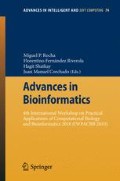Abstract
Several authors have being suggesting that the occurrence of amino acids repeats in some genes are implied in human diseases. We aim to investigate if these repetitions, which one can observe in humans, also exist in orthologous genes of several organisms, and how they have evolved along time. However, for this kind of study, it is necessary to use different databases and computation methods that are not integrated in any specific tool. In this paper, we present a bioinformatics application, supported by Web Services, that allows to conduct comparative analysis studies for various organisms, along the evolutionary chain.
Access this chapter
Tax calculation will be finalised at checkout
Purchases are for personal use only
Preview
Unable to display preview. Download preview PDF.
References
George, R.A., Liu, J.Y., Feng, L.L., Bryson-Richardson, R.J., Fatkin, D., Wouters, M.A.: Analysis of protein sequence and interaction data for candidate disease gene prediction. Nucl. Acids Res. 34, e130 (2006)
Sher Ali, S.A., Ehtesham, N.Z., Azfer, M.A., Homkar, U., Rajesh Gopal, S.E.H.: Analysis of the evolutionarily conserved repeat motifs in the genome of the highly endangered central Indian swamp deer Cervus duvauceli branderi. GENE. 223, 361–367 (1998)
Fu, Z., Jiang, T.: Clustering of main orthologs for multiple genomes. J. Bioinform. Comput. Biol. 6, 573–584 (2008)
Jones, N.C., Pevzner, P.A.: Comparative genomics reveals unusually long motifs in mammalian genomes. Bioinformatics 22, e236–e242 (2006)
Lab, P.: Repeat Disease Database (2009), http://www.cepearsonlab.com/rdd.php
Brameier, M., Wiuf, C.: Ab initio identification of human microRNAs based on structure motifs. BMC Bioinformatics 8, 478 (2007)
Bowen, T.A., Guy, C.A.A., Cardno, A.G.A.B., Vincent, J.B.C., Kennedy, J.L.C., Jones, L.A.A., Gray, M.A., Sanders, R.D.A., McCarthy, G.A., Murphy, K.C.A., Owen, M.J.A.B., O’Donovan, M.C.A.: Repeat sizes at CAG/CTG loci CTG18.1, ERDA1 and TGC13-7a in schizophrenia. Psychiatric Genetics 10, 33–37 (2000)
Ferro, P., Catalano, M.G., Dell’Eva, R., Fortunati, N., Pfeffer, U.: The androgen receptor CAG repeat: a modifier of carcinogenesis? Molecular and Cellular Endocrinology 193, 109–120 (2002)
Pestova, T.V., Hellen, C.U., Wimmer, E.: A conserved AUG triplet in the 5’ nontranslated region of poliovirus can function as an initiation codon in vitro and in vivo. Virology 204, 729–737 (1994)
Freed, K.A., Cooper, D.W., Brennecke, S.P., Moses, E.K.: Detection of CAG repeats in pre-eclampsia/eclampsia using the repeat expansion detection method. Mol. Hum. Reprod. 11, 481–487 (2005)
Herishanu, Y.O., Parvari, R., Pollack, Y., Shelef, I., Marom, B., Martino, T., Cannella, M., Squitieri, F.: Huntington disease in subjects from an Israeli Karaite community carrying alleles of intermediate and expanded CAG repeats in the HTT gene: Huntington disease or phenocopy? Journal of the Neurological Sciences 277, 143–146 (2009)
Bogaerts, V., Theuns, J., van Broeckhoven, C.: Genetic findings in Parkinson’s disease and translation into treatment: a leading role for mitochondria? Genes. Brain. Behav. 7, 129–151 (2008)
Mena, M.A., Rodriguez-Navarro, J.A., Ros, R., de Yebenes, J.G.: On the pathogenesis and neuroprotective treatment of Parkinson disease: what have we learned from the genetic forms of this disease? Curr. Med. Chem. 15, 2305–2320 (2008)
Tarini, B.A., Singer, D., Clark, S.J., Davis, M.M.: Parents’ Interest in Predictive Genetic Testing for Their Children When a Disease Has No Treatment. Pediatrics (2009)
Hsueh, W.: Genetic discoveries as the basis of personalized therapy: rosiglitazone treatment of Alzheimer’s disease. Pharmacogenomics J. 6, 222–224 (2006)
Pearson, C.E., Edumura, N.K., Cleary, J.D.: instability: mechanisms of dynamic mutations. Nat. Rev. Genet. 6, 729–742 (2005)
Lousado, J., Oliveira, J., Moura, G., Santos, M.: Analysing the Evolution of Repetitive Strands in Genomes. In: Omatu, S., Rocha, M.P., Bravo, J., Fernández, F., Corchado, E., Bustillo, A., Corchado, J.M. (eds.) IWANN 2009. LNCS, vol. 5518, pp. 1047–1054. Springer, Heidelberg (2009)
KEGG: Kyoto Encyclopedia of Genes and Genomes. Kanehisa Laboratories, http://www.kegg.com
OMIM, Online Mendelian Inheritance in Man, http://www.ncbi.nlm.nih.gov/omim/
Hamosh, A., Scott, A., Amberger, J., Bocchini, C., McKusick, V.: Online Mendelian Inheritance in Man (OMIM), a knowledgebase of human genes and genetic disorders. Nucleic Acids Research 33, D514 (2005)
Kanehisa, M., Goto, S., Furumichi, M., Tanabe, M., Hirakawa, M.: KEGG for representation and analysis of molecular networks involving diseases and drugs. Nucl. Acids Res. 38, D355–D360 (2010)
Author information
Authors and Affiliations
Editor information
Editors and Affiliations
Rights and permissions
Copyright information
© 2010 Springer-Verlag Berlin Heidelberg
About this paper
Cite this paper
Lousado, J.P., Oliveira, J.L., Moura, G., Santos, M.A.S. (2010). An Application for Studying Tandem Repeats in Orthologous Genes. In: Rocha, M.P., Riverola, F.F., Shatkay, H., Corchado, J.M. (eds) Advances in Bioinformatics. Advances in Intelligent and Soft Computing, vol 74. Springer, Berlin, Heidelberg. https://doi.org/10.1007/978-3-642-13214-8_14
Download citation
DOI: https://doi.org/10.1007/978-3-642-13214-8_14
Publisher Name: Springer, Berlin, Heidelberg
Print ISBN: 978-3-642-13213-1
Online ISBN: 978-3-642-13214-8
eBook Packages: EngineeringEngineering (R0)

